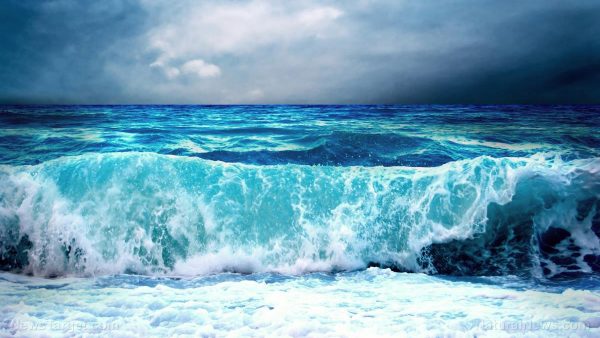
Rogue waves are massive "walls of water" in the open ocean
According to the National Oceanic and Atmospheric Association (NOAA), rogue waves are massive "walls of water" that form and disappear in the open ocean. They are different from tsunamis, which are caused by disturbed water from underwater earthquakes, landslides or volcanic eruptions and do not become enormous until they approach the coast. A rogue wave is scientifically described as being at least twice as tall as the surrounding sea state — the average height of the waves for a given region at a given time. NOAA researchers believe rogue waves are formed when smaller waves combine into larger ones, either due to high surface winds or changes in ocean currents brought by storms. Nevertheless, the precise mechanisms behind the unusual crests are still something of a mystery, according to the statement. The first officially recognized rogue wave is called the Draupner wave, which happened in Norway in 1995, although scientists have suspected the existence of rogue waves long ago. Stories of sailors being caught out or even killed by unusually huge waves have long filled maritime folklore, but until that 1995 report, scientists have never noticed them. Scientists have examined only a handful of rogue waves since then, but they believe that one forms every two days somewhere in the world's oceans.Draupner wave estimated to be 84 feet high
The Ucluelet wave is not the largest rogue wave ever recorded. The Draupner wave, for example, was estimated to be 84 feet high. However, the sea state during the Draupner wave was around 39 feet, making the rogue wave just over twice as tall as surrounding waves. Rogue waves are normally ignored. However, if a ship or oil rig were to be caught in one of these freakishly huge crests, the result could be disastrous. "The unpredictability of rogue waves, and the sheer power of these 'walls of water' can make them incredibly dangerous to marine operations and the public," said MarineLabs CEO Scott Beatty. But researchers hope that grids of monitoring buoys, such as the 26 MarineLabs buoys strategically positioned along North American coastlines, could disclose more about these oceanic anomalies. "The potential of predicting rogue waves remains an open question, but our data is helping to better understand when, where and how rogue waves form, and the risks that they pose," Beatty added. Researchers commonly use buoys to help determine the heights of large waves. For this study, the MarineLabs buoy recorded data in 20-minute bursts every 30 minutes. Researchers then examined the data until May 21, 2021 to verify its results. "Most observations are at a single buoy, a single location, and so the wave passes through. And we know at this moment it was this high, but we don't know how long. That is the big science question," Gemmrich said. Other important questions researchers are hoping to answer include figuring out how rogue waves are formed so that they can better predict when they will occur. Advanced buoy technology might be a good starting point. "We are aiming to improve safety and decision-making for marine operations and coastal communities through widespread measurement of the world's coastlines," Beatty said. "Capturing this once-in-a-millennium wave, right in our backyard, is a thrilling indicator of the power of coastal intelligence to transform marine safety."More related stories:
Scientists have warned that a 400 foot tsunami could hit the East Coast if an asteroid hit the Atlantic Ocean. Study: Asteroid hitting the North Atlantic will unleash 400-feet high tsunami to the East Coast. Humans are making oceans noisier, hurting all marine life. Undersea earthquakes hit 2 of the world's major oceans. Watch the video below to know more about massive waves surge and blue waves. This video is from the ZGoldenReport channel on Brighteon.com. Find more stories about the world's oceans at OceanHealthNews.com. Sources include: LiveScience.com TheSun.co.ukAmerican children are losing millions of IQ points thanks to exposure to toxic chemicals
By Cassie B. // Share
LUNAR MYSTERY: Rusty patches found on moon’s surface despite its lack of rust-inducing ingredients
By Kevin Hughes // Share
Scientists develop fast method of detecting toxin from pesticides and chemical weapons
By Divina Ramirez // Share
An ancient volcano lurks beneath Germany – is it capable of erupting?
By Virgilio Marin // Share
Sustainable farming: 7 Indigenous practices to preserve crop and soil health
By Virgilio Marin // Share
ESG scoring drives companies into sustainable development, aka technocracy
By News Editors // Share
An invisible assault: How everyday heavy metals sabotage brain health
By willowt // Share
Pentagon warns of China's rapidly expanding nuclear arsenal
By kevinhughes // Share
FCC grounds new Chinese drones in sweeping security move
By avagrace // Share
The methylation switch: Scientists identify diet that can turn back the cellular clock
By jacobthomas // Share
Renaissance or Ruin: A wake-up call for cultural revival and self-sufficiency
By kevinhughes // Share
Weight loss in midlife may trigger brain inflammation, study finds
By avagrace // Share











